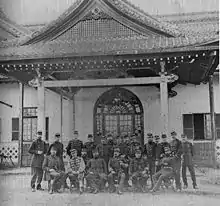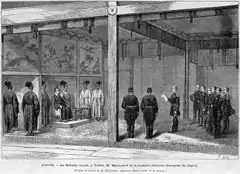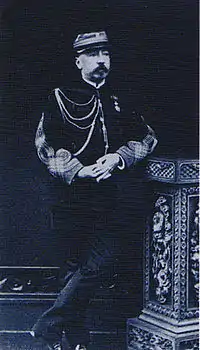French military mission to Japan (1872–80)
The 1872–1880 French military mission to Japan was the second French military mission to that country. It followed the first French military mission to Japan (1867–68), which had ended with the Boshin War and the establishment of the rule of Emperor Meiji.

Background
The formation of a second military mission to Japan was rather a surprise, as the first French military mission had sided with the shōgun Tokugawa Yoshinobu against the ruling government of Emperor Meiji during the Boshin War. Furthermore, France had lost some of its military prestige, due to its defeat during the Franco-Prussian War.
Nevertheless, France still retained some attractiveness for Japan. This was expressed by the Japanese foreign minister Iwakura Tomomi during his visit (the Iwakura mission) to France in 1873:
The Minister for Foreign Affairs of the Mikado (Iwakura) said to our representative after our fatal combat against Germany: "We know about the sufferance France had to go through in this war, but it has not changed anything in our opinion on the merits of the French army, which showed great courage in the face of numerically superior troops"
— Revue des Deux Mondes (March–April 1873). Le Japon depuis l'Abolition du Taïcounat[1]
The mission

The mission arrived in Japan in May 1872, headed by Lieutenant Colonel Charles Antoine Marquerie (1824–1894). He was later replaced by Colonel Charles Claude Munier.
The mission was composed of nine officers, 14 non-commissioned officers, a music chief (Gustave Désiré Dragon), a veterinarian, and two craftsmen. A famous member of the mission was Louis Kreitmann (1851–1914), an army engineer and captain ("Capitaine du Génie"). Louis Kreitmann would later become director of the prestigious École Polytechnique. Kreitmann took about 500 photographs, which are now held at the Institut des Hautes Études Japonaises (Collège de France), Paris.
The members of the mission were hired with three-year contracts, with monthly salaries from 150 to 400 yen (for comparison, at the time the salary of the Japanese Prime Minister was 500 yen, and a newly graduated school teacher would receive 5 yen monthly).
Activities
The task of the mission was to help reorganize the Imperial Japanese Army, and establish the first draft law, enacted in January 1873. The law established military service for all males, for a duration of three years, with an additional four years in the reserve.
The French mission was essentially active at the Ueno Military School for non-commissioned officers. Between 1872 and 1880, various schools and military establishments were set up under the direction of the mission, including:

- Establishment of the Toyama Gakko, the first school to train and educate officers and noncommissioned officers.
- A shooting school, using French rifles.
- An arsenal for gun and munition manufacture, equipped with French machinery, which employed 2500 workers.
- Artillery batteries in the suburbs of Tokyo.
- A gunpowder factory.
- A Military Academy for Army officers in Ichigaya, inaugurated in 1875, on the ground of today's Ministry of Defense.
Between 1874 and the end of their term, the mission was in charge of building Japan's coastal defenses.
The mission occurred at the time of a tense internal situation in Japan, with the revolt of Saigō Takamori in the Satsuma rebellion, and contributed significantly to the modernization of Imperial forces before the conflict.
Some members of the mission also endeavoured to learn Japanese martial arts: Villaret and Kiehl were members of the dojo of Sakakibara Kenkichi, a master of Jikishinkage-ryu, a form of swordsmanship (Kenjutsu), making them some of the first western students of Japanese martial arts.[2]
Legacy
A third French military mission to Japan (1884–89) would take place with five men, but Japan also involved Germany for military advice from 1886 to 1889.
Around that time however, France gained considerable influence over the Imperial Japanese Navy, with the despatch of the engineer Louis-Émile Bertin, who directed the design and construction of Japan's first large-scale modern Navy from 1886.
Some other members of the mission

- Armand Pierre André Echeman (April 11, 1872 – January 18, 1875). Infantry Captain (military exercises, shooting, physical training, and theory).
- Joseph Auguste Cros (April 11, 1872 – February 29, 1876) Infantry Sublieutenant (military exercises, shooting, physical training and theory).
- François Joseph Ducros (May 26, – April 10, 1877) Infantry Sergeant (instruction in physical training).
- Alexandre Étienne Bouguin (October 29, 1875 – December 31, 1879) Infantry Lieutenant (shooting theory).
- Joseph Kiehl (September 27, 1884 – July 24, 1887). Master-at-Arms and Marshal of the Logis (teacher of physical training and swordsmanship)
- Étienne de Villaret (October 29, 1884 – October 28, 1887). Lieutenant (strategy, shooting theory and technique).
- Henri Berthaut (hired on October 29, 1884) Lieutenant (Administration of the Mission, timetable of courses). Rehired on October 29, 1886.
- Henri Lefèbvre (September 25, 1887 – January 26, 1889) Infantry Captain (strategy, shooting, theory of physical exercise).
References
Notes
- Ichikawa, Shin-ichi (March 2003). "La Mission Iwakura (1871–1873) et la France: ce que virent en Europe les Japonais de l'époque Meiji" (PDF). Bulletin of the Institute for Mediterranean Studies (in French). Shinjuku, Tokyo: Institute for Mediterranean Studies, Waseda University (4). ISSN 1348-2076. Retrieved October 11, 2014.
- Watanabe, Ichiro (1971). 明治武道史 [Meiji Budo-shi] [A History of Budo in the Meiji Period] (in Japanese). Tokyo: Shin Jinbutsu Oraisha, Showa 46. OCLC 15374653. Retrieved October 11, 2014.
Bibliography
- Kreitmann, Louis; Kreitmann, Pierre; Uméda, Masami (1995). Deux ans au Japon 1876–1878 = 二年間の日本滯在 1876–1878. 1, Carnets de route [Two years in Japan 1876–1878. 1, Travel reports] (in French and Japanese). Marseille: published at the author. OCLC 51106062.
- Kreitmann, Louis; Kreitmann, Pierre; Uméda, Masami (1996). Deux ans au Japon 1876–1878 = 二年間の日本滯在 1876–1878. 2, Carnets de route et des lettres [Two years in Japan 1876–1878. 2, Travel reports and letters] (in French and Japanese). Marseille: published at the author. OCLC 863854214.
- Fiévé, Nicolas; Matsuzaki-Petimengin, Sekiko (dir.); Institut des Hautes Études Japonaises du Collège de France/Équipe, Civilisation japonaise du CNRS/Nihon Toshokan Kyôkai (2005). フランス士官が見た近代日本のあけぼの―ルイ・クレットマン・コレクション = Collection Louis Kreitmann. L'aube du Japon moderne vue par un officier français au cours des années 1876–1878 [Collection Louis Kreitmann. The dawn of modern Japan as seen by a French officer in the years 1876–1878] (in Japanese and French). Tokyo: IRD Co.Ltd. ISBN 978-4-901061-10-0. External link in
|title=(help) - Polak, Christian (May 2002). 絹と光 : 知られざる日仏交流100年の歴史 : 江戸時代~1950年代 = Soie et Lumières, l'âge d'or des échanges franco-japonais (des origines à l'après-guerre) [Silk and Enlightenment, the golden age of Franco-Japanese trade (from the origins to the post-war)] (in Japanese and French). Tokyo: Chambre du commerce et d’industrie Française du Japon, Hachette Fujingahôsha. ISBN 978-4-573-06210-8. OCLC 718252365. External link in
|title=(help) - Nishibori, Akira (1984). 日仏文化交流年表 [Franco-Japanese cultural exchange chronology] (in Japanese). Ichikawa: 日仏関係研究センター[Franco-Japanese Relations Research Center]. OCLC 47481721.
- Polack, Christian. "Étienne de Villaret". VU! Magazine.
- Nishibori, Akira (2008). 日本の近代化とグランド・ゼコール : 黎明期の日仏交流 : 日仏会館教養講座 [Maison Franco-Japonaise liberal arts courses: Franco-Japanese Interactions in the Early Stage: Grand Ecoles and modernization of Japan] (in Japanese). Tokyo: Tsuge Shobō Shinsha. ISBN 978-4806805861. OCLC 277275342.
- Watanabe, Ichirō (1971). 明治武道史 [Meiji martial arts history] (in Japanese). Tokyo: Shinjinbutsu Ōraisha, Shōwa 46. OCLC 15374653.
- 陸軍教育史 [Army History of Education] (in Japanese). 1913.
- Hideaki, Kinoshita (April 21, 1983). "陸軍戸山学校の体育 [Rikugun Toyama Gakko no Taiiku]" [Physical Education in Toyama Military Academy]. オリンピック [Olympic]. 21 (July 22, 1983): 6–9.
- Hideaki, Kinoshita (November 1979). "経歴からみた戸山学校の教官構成 = Rekishi kara mita Toyama Kakko no Kyokan Kyosei". 日本体育学会大会号 [Japanese Society of Physical Education]. 30 (30): 106.
- Hideaki, Kinoshita (1981). "質問紙の史料価値についての検討" [Examination of historical value of the question paper]. 日本大学人文科学研究所研究紀要 / 日本大学人文科学研究所 [編] (25): 142–166.
- Hideaki, Kinoshita (December 17, 1978). "旧陸軍戸山学校卒業生数" [Number of graduates in the former Toyama Military Academy]. 日本体育学会大会号 (29): 81.
- Bernard, Hervé (2007). L'ingénieur général du génie maritime Louis, Emile Bertin 1840–1924 créateur de la marine militaire du Japon à l'époque de Meiji Tenno (in French). self-publishing.
- Bernard, Hervé (2007). Ambassadeur au pays du Soleil Levant dans l'ancien Empire du Japon (in French). self-publishing.